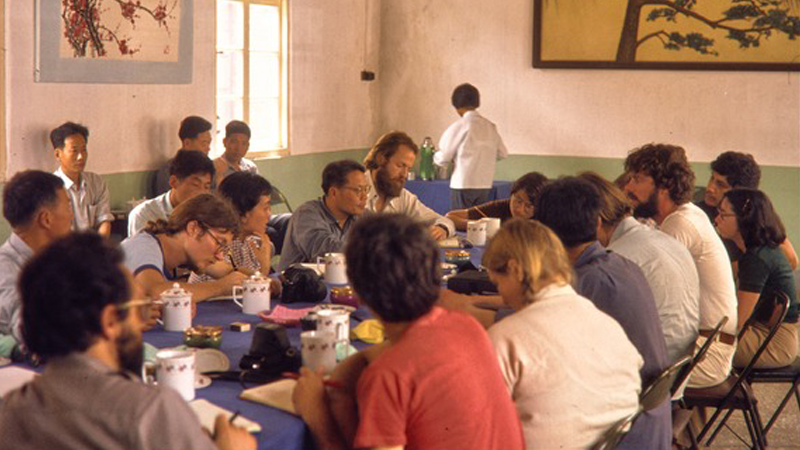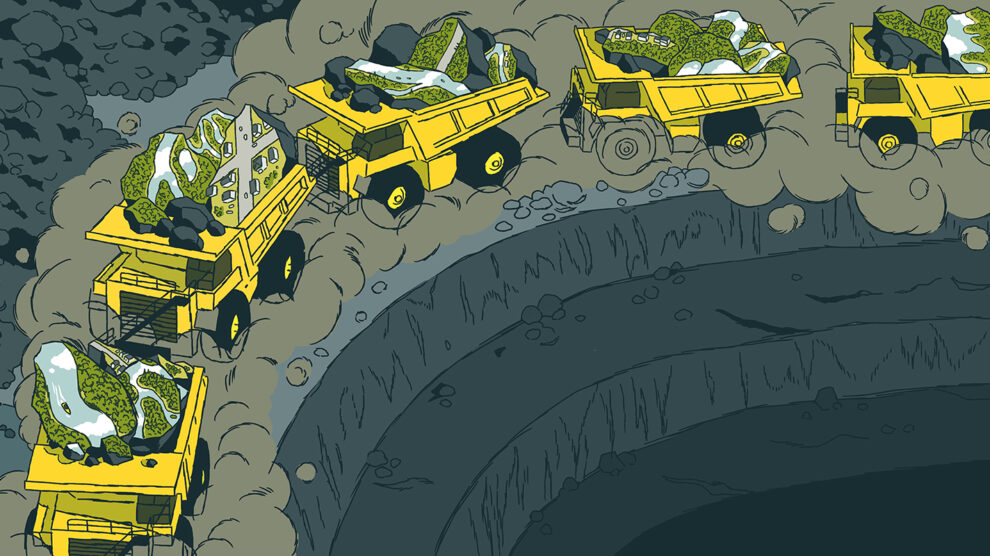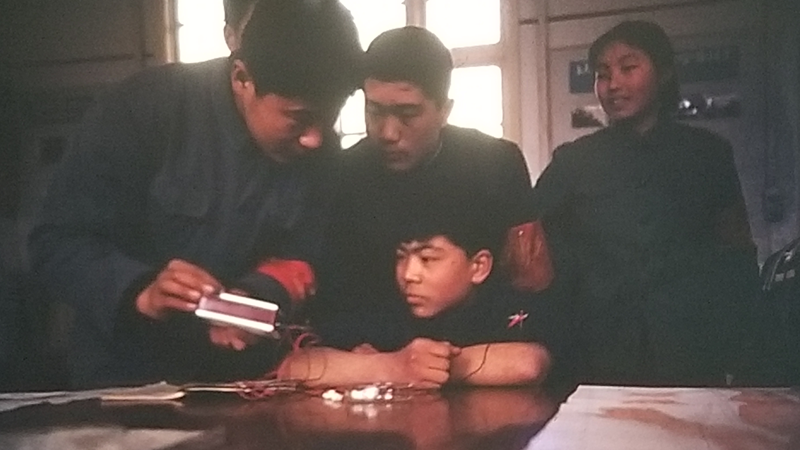Earthy Knowledge: Rethinking Chinese Terracing Campaigns
By Sigrid Schmalzer
Volume 25, no. 1, The Soil and the Worker
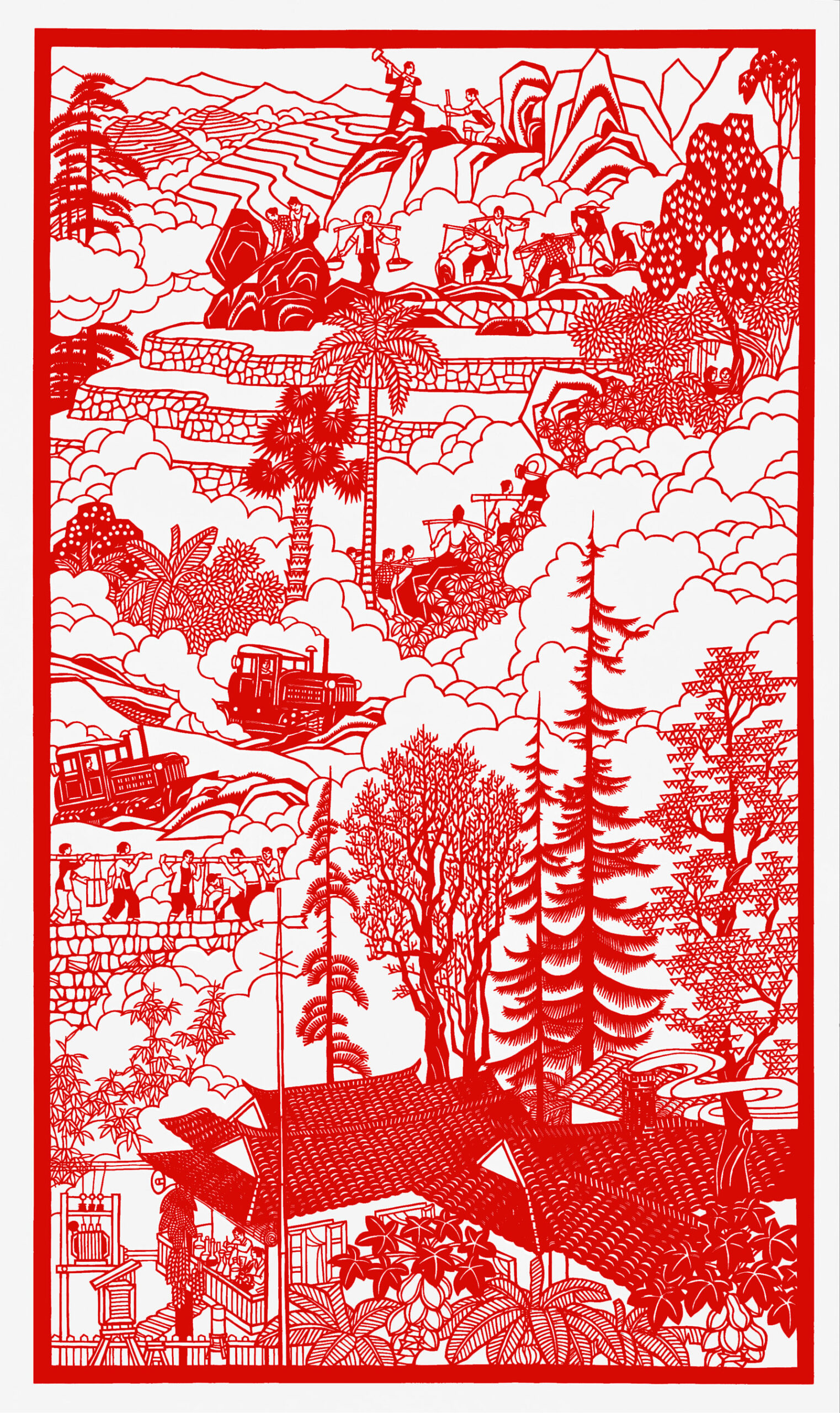
A few years ago a friend in the local agriculture movement recommended I watch a film called Hope in a Changing Climate. Directed by soil scientist John Liu, the 2009 documentary features agricultural terracing practices that restore lands all but lost to erosion through centuries of overuse, in the process also sequestering carbon and thus promising to slow climate change. The film begins in northern China with a project that since the 1990s has been successfully using agricultural terracing to transform denuded hills on the Loess Plateau. Liu then travels to Ethiopia and Rwanda where similar efforts have had equally dramatic results.1
Although impressed and inspired, I was struck by an absence, summed up by one word: Dazhai (大寨). To any student of recent Chinese history, not to mention people who lived through the 1960s and 1970s in China, the mass mobilization of peasants to build agricultural terraces cannot but evoke thoughts of the campaign to “Study Dazhai in Agriculture.” Dazhai is a village in the Taihang Mountains of northern China: the most memorable endeavor this rural community cum national model undertook was the construction of terraces to conserve water and soil, changing “barren hills” into productive farmland.
People today, in China and abroad, often seem to forget that past—or to remember it only selectively. After Mao’s death and the subsequent initiation of market reforms, many aspects of the Mao era (1949–76) were repudiated. In the new political context, what had once served as a testament to the power of the masses, and an exemplar of resource conservation, became evidence of the futility, irrationality, hubris, and above all environmental destructiveness of Maoist efforts to control nature for human ends.
But as an activist historian, it is my job to make sure we don’t forget, and to show how a bolder, fuller understanding of history will aid our political work today. The history of Mao-era Chinese terracing campaigns brings into focus both of what Karl Marx called the “original sources of all wealth,” namely, “the soil and the worker.” Specifically, it highlights efforts to conserve soil resources, and it raises complicated questions about labor and its relationship to science. I title this essay “Earthy Knowledge” to capture both of these elements: the soil itself and the ideal of mass-based science that in Mao-era China was called tu (土)—literally, “soil.”
Conservation and Critique: Overlooked Maoist Legacies
In 1973, a member of Science for the People’s delegation to China recorded his feelings upon witnessing the terraced hills of Xigou Commune on the Loess Plateau: “We … couldn’t help but feel we had some kind of gut understanding for why the peasants love Chairman Mao. Ravine after ravine terraced to the brim. Hopeless land brought into production.”2 A 2.5’×1.5’ paper cutting, brought home in 1978 by another SftP member who visited China, illustrates this vision powerfully. And SftP radicals were not alone: mainstream liberal scientists traveling to China in the 1970s returned to the US to paint optimistic portraits of the social and ecological benefits of Mao-era agricultural science and technology.3
By the mid-1980s, the tide had turned. Vaclav Smil’s 1984 The Bad Earth: Environmental Degradation in China set the stage for a chorus of similar accounts. In her 2001 book Mao’s War against Nature, Judith Shapiro cited example after example in which the Dazhai model was “blindly implemented in ecologically divergent regions,” with such absurd-sounding slogans as “on flatlands, construct terraces.”4 More recently, Charles Mann’s widely read book 1493 quoted Smil saying, “It must be one of the greatest wastes of human labor in history. . . . Tens of millions of people being forced to work night and day, most of it on projects that a child could have seen were a terrible stupidity. Cutting down trees and planting grain on steep slopes—how could that be a good idea?”5 Together, these histories leave us with a picture of Mao-era terracing campaigns as fundamentally irrational manifestations of a rabidly destructive ideology.
There is some truth to these accounts, and much testimony from sources in China to support them.6 Indeed, the critiques that Shapiro and others have leveled against the Study Dazhai campaign echo critiques in the Chinese literature—the term “blindly implemented” and the specific examples of absurd policies are familiar fare. A 1980 article published in none other than the People’s Daily offered an especially biting criticism, squarely aimed at Mao-era authoritarianism. “One gram of uranium, when processed, can release a tremendous amount of energy, and a laser beam can pierce through thick steel. But they pale in comparison with the sound waves produced by an ordinary whistle. A whistle? That’s right: I mean the iron whistle that our comrades involved in rural labor often blow.” During the Mao era, the author argued, that whistle had become “a tool of authority” with the power “to order, control, punish, or slap a label on any farmer who dared defy” commands from above. “‘Toot! Truly or falsely studying Dazhai, that’s the dividing line between the two classes and the two roads.’ And so we ended up building terraces in the plains…”7 In other words, authorities used Dazhai and other examples as ways to enforce the party line on the “two classes” (laborers and bourgeoisie) and the “two roads” (socialism and capitalism).
The Mao era not only offers cautionary examples of environmentally damaging activities; it also provides incisive analytical tools for criticizing those travesties, along with inspiring examples of environmental conservation.
More recently, a Chinese journal article critiqued the Study Dazhai campaign as an example of “cutting with a single stroke of the knife” (一刀切, the imposition of uniformity). The authors acknowledged that the ideal of uniformity may encourage fairness and adherence to standards, but they emphasized that a policy that suits one place will not necessarily suit every place. Testing policies at multiple sites thus offers a necessary antidote to “cutting with a single stroke of the knife.”8
Despite the validity of these critiques, they typically fail to do justice to the sincerity, and often success, of Mao-era efforts to use terracing for environmental conservation. In many places, terraces constructed during the Mao era continue to be maintained today because they serve agricultural production while preventing erosion. There are even places where terracing is recognized as an aspect of “agricultural heritage,” and yet a significant portion of the existing terraces were built not during centuries past, but during the Mao era.9 And, while in some areas trees were felled to convert hillsides into terraced farmland, in many others bare hillsides were terraced and planted with trees, or with grain lined by fruit trees along the weirs (terrace walls): indeed, tree-planting was an explicit part of Mao-era terracing campaigns.
Critics of Mao-era terracing also typically fail to acknowledge the Mao-era sources of their critical insights: that is, the concerns they raise are often the same as those they have read in Mao-era materials, articulated by people committed to Maoist scientific principles, especially regarding the promotion of local experimentation and resistance to inappropriate outside models. The phrase “cutting with a single stroke of the knife” appeared frequently in Mao-era criticisms of uniformity. For example, a People’s Daily article from 1972 discussed a county on Hainan island where the proximity to both ocean and mountains created diverse conditions. When county leaders allegedly attempted to “cut with a single stroke of the knife,” local cadres rebelled, saying, “We truly cannot do that here.” The article argued that the true meaning of studying Dazhai lay in investigating local conditions, listening to the perspectives of the masses, and studying Mao’s exhortation to “make work plans based on practical circumstances.” And so, instead of cutting with a single stroke of the knife, county leaders reportedly learned to find “a different key to open every lock.”10
In sum, the Mao era not only offers cautionary examples of environmentally damaging activities (including some poorly conceived terracing projects); it also provides incisive analytical tools for criticizing those travesties, along with inspiring examples of environmental conservation.
Labor and Knowledge: Enduring Maoist Priorities
During the Mao era, the Chinese character 土 (pronounced tu) held multiple potent meanings. At the material level, it meant the actual soil that farmers plowed and sowed to grow crops. As Marx recognized, all production depends on the soil: without careful attention to nutrient replenishment, resources are depleted and the “metabolic interaction between humans and the earth” disrupted—which Marx argued was occurring in his time at the hands of agricultural capitalists.11 In China, where much of the land is mountainous, and farming on the slopes a necessity in many communities, erosion presents another serious challenge to soil conservation. Hence, by the 1950s, the PRC state had already begun studying terracing practices as part of a major emphasis on conservation of water and soil (水土保持).
Tu also stood symbolically for a distinctive form of science rooted in earthy knowledge. Whereas yang (洋, “ocean”) connoted foreign / ivory-tower / professional science, tu (土) represented native / grassroots / peasant-based science.12 Officially, the policy was to “combine yang and tu,” or as SftP emphasized in the title of their 1974 book on China, to create a science that “walks on two legs.” In part this was a strategy born of necessity, making up for gaps in advanced technologies with low-tech supplements. But Mao and other radicals went further, arguing that peasant knowledge, accumulated through labor experience, represented a rich storehouse that would ensure a truly revolutionary path for socialist Chinese science. Reflecting this principle, the 1964 article in People’s Daily that introduced the Chinese public to the model community of Dazhai celebrated the peasants’ grit: “A clenched hoe, a hoisted shovel, a broken basket, and a stiff shoulder-pole—these are their tools.”13
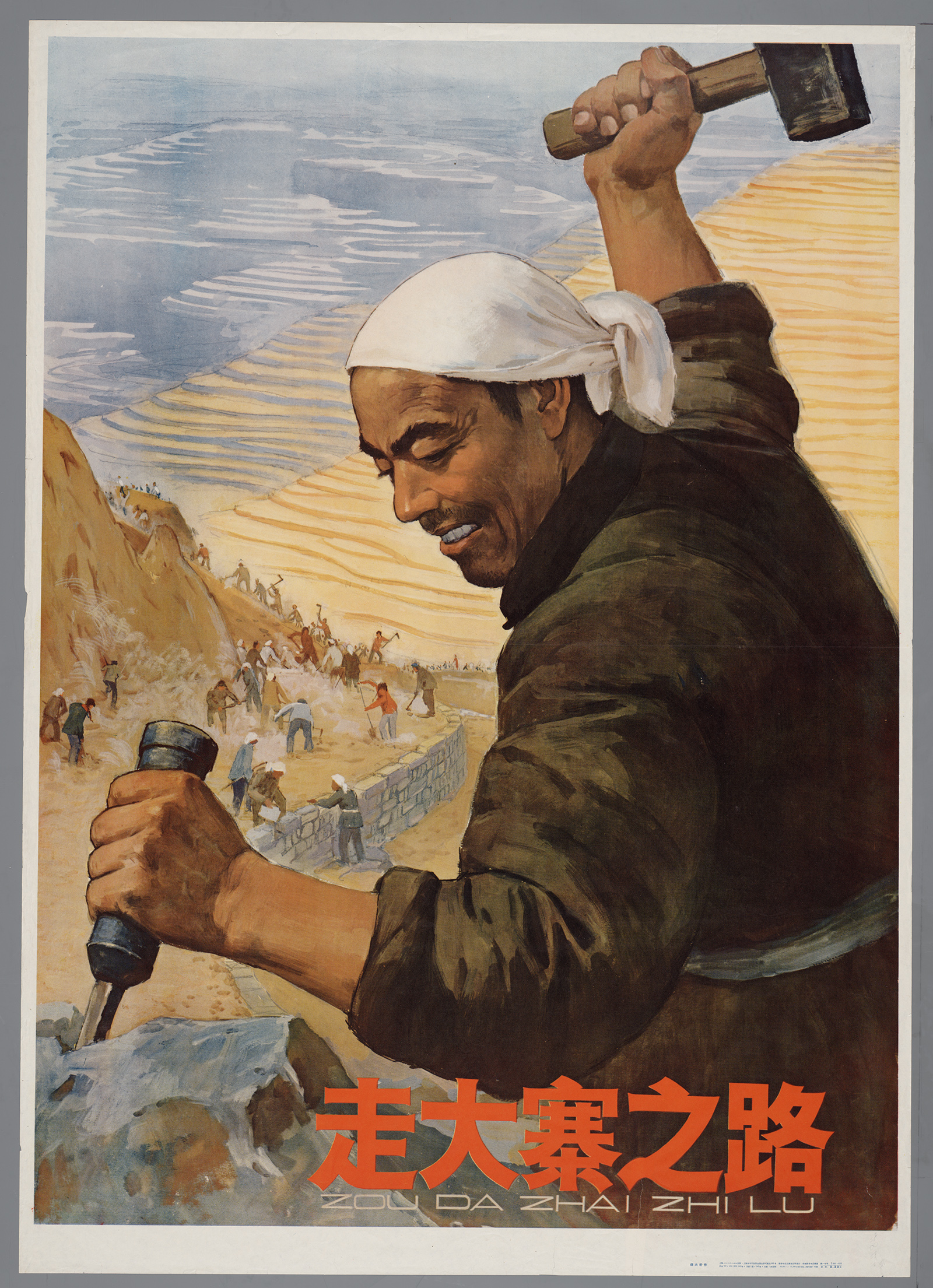
Throughout the Mao era, the grueling labor required to construct terraces was valorized. In the process, people were often pushed past healthy levels of endurance. Writings from those days were filled with inspirational, but also ominous, stories—like that of a 74-year-old man who was praised for continuing to terrace until three days before his death: with his last breath he was reportedly still talking about terracing.14 Such stories help us realize the legitimacy of criticisms of Mao-era campaigns. Though they do not tell the whole story, they do speak to the truth of many people’s experiences.
The claim that terracing campaigns represented something revolutionary and liberatory, and not just an effort to squeeze more labor out of local people, depended on the premise that labor is not mindless, but rather embodies scientific knowledge and technological skill. As a 1975 article put it, “The practice of constructing Dazhai fields proves that the laboring people are the masters of soil science.” Moreover, the peasants’ science had “powerfully refuted” the so-called “law of decreasing soil fertility.” In the old society, the same forces that exploited the laboring people had also depleted the fertility of the soil; “reactionary scholars” became “apologists” for the exploiting classes by arguing soil depletion was natural “law.” The people of Dazhai had proven them wrong by developing practices that combated erosion and created nutrient-dense, microbiotically active “living soil” that could withstand both drought and flood.15
The people most credited for the success of such technologies were those with the most labor experience: “old peasants.” For example, in She County, Hebei (a place not far from Dazhai in the Taihang Mountains, which boasted centuries of terracing history), Mao-era campaigns emphasized the importance of “old hands leading new hands.” An old party member, Wang Tingheng, instructed a technology leadership group in preserving soil, following the mountain topography, and selecting suitable stones to construct weirs. Thus, “the old led the new; one transmitted his knowledge to five; five transmitted to ten; and the technology problem was solved.”16
Maoist respect for the wisdom of old peasants was different in important ways from current leftist veneration of Indigenous knowledge preserved by community elders.
Students of history, and especially of revolutionary historical periods, face the perennial problem of determining the degree to which rhetoric reflected the ideas and experiences of actual people. The evidence suggests that at least some, but by no means all, scientific and political elites in Mao-era China did genuinely respect the contributions peasants made to science. The voices of peasants are harder to recover, since they very rarely left records in their own words. The most we can say is that the esteem granted to old peasants as wielders of scientific knowledge was an expression of a political value promoted by Mao and other radical leaders. Those same leaders would have readily admitted that the transformation of the social relations of science was by no means complete, but would require ongoing struggle.
Maoist respect for the wisdom of old peasants was different in important ways from current leftist veneration of Indigenous knowledge preserved by community elders. In particular, Maoist hostility to “tradition” precluded recognition of the cultural contexts that had produced agricultural technologies. Somewhat ironically (given the socialist preference for collectivism), Mao-era writings instead emphasized the contributions of individual peasants whose knowledge came from their own practical experience in labor. A striking example: Dazhai party secretary and labor model Chen Yonggui (figure 1) was said to have invented arched weirs to protect sections of terraces subject to particularly strong flood waters. In fact, this technology had long been used in the Taihang Mountains.17
The reluctance in the Mao era to recognize the significance of traditional culture was especially pronounced when it came to so-called “backward” ethnic groups in the mountains of southwest China. For example, in 1958 an article praised a Lahu nationality man for rejecting the traditional practice of slash-and-burn agriculture; with the steadfast support of a local official (whose name suggested he was probably Han Chinese), the man reportedly introduced terracing to the area.18 Even communities that traditionally practiced terracing were said to require assistance to modernize their technologies, and were congratulated for following the model of Dazhai. Today, the significance of “traditional” knowledge in terracing communities is far better recognized. Indeed, in the new economy, it is actively marketed for its value in “heritage tourism.” However, the concept of “indigenous knowledge” remains politically sensitive: the PRC state has not embraced the term “indigenous” to refer to minority ethnic groups in China and does not characterize the relationship between the Han majority and ethnic minorities as colonial.19
Lessons for the Left
A historical look at Chinese terracing campaigns offers a useful way to dig into questions facing the left today. I take three lessons from this history.
First, we must revise the overly negative verdict on Mao-era terracing, which grew out of a triumphalist eagerness to discredit the ancien régime of radical Maoism. The need for a clearer understanding of this history is sharpened by the ecological significance of current terracing efforts in China and abroad.
Second, the Maoist critical toolkit remains a powerful, though rarely acknowledged, resource for environmentalists seeking to promote locally appropriate agricultural technologies. In particular, Mao-era writings emphasized the importance of grassroots, mass-based experimentation and the need to resist the imposition of outside models unsuited to local conditions. At the same time, we must acknowledge the flip side: those admonitions appear so frequently in the historical record in part because conservation efforts were so often undermined by the dogmatic imposition of practices associated with national models like Dazhai—so aptly critiqued as an “iron whistle” in the 1980 People’s Daily article discussed above. We would be wise to cultivate an awareness of such contradictory forces in our own movements.
Third, the Mao-era emphasis on knowledge as a product of individual experience in the practice of labor contrasts sharply with current Chinese enthusiasm for knowledge rooted in traditional culture, and even more with current global interest in indigenous knowledge. Labor, tradition, and indigeneity all speak to “earthy” knowledge, but they have different implications for our political practice. Leftists in the west are considerably less likely today than we were fifty years ago to view traditional social structures and cultural practices as sources of political and economic “backwardness” and thus legitimate sites for state intervention. We are more likely to valorize traditional cultures, especially those associated with indigenous peoples, as essential antidotes to Western modernity. Yet, even as we rightly honor some traditional forms of knowledge, we might reflect on the continued need to critique aspects of traditional social structures that are less than liberatory. And we might draw from Mao-era epistemology a reminder of the role of labor in shaping knowledge—including knowledge of the soil, that crucial source of all wealth, and of life itself.
Notes
- Hope in a Changing Climate, directed by John Liu (2009), https://youtu.be/bLdNhZ6kAzo.
- Anonymous SftP delegate’s personal journal, in the author’s collection.
- See, among many examples, American Insect Control Delegation, Insect Control in the People’s Republic of China (Washington, DC: National Academy of Sciences, 1977).
- Judith Shapiro, Mao’s War against Nature: Politics and the Environment in Revolutionary China (Cambridge: Cambridge University Press, 2001), 101, 106–14. Notably, Shapiro’s more recent book, co-authored with Yifei Li, critiques current environmental policy in the PRC and in the process offers a considerably more balanced perspective on the Mao era’s environmental legacy. See Yifei Li and Judith Shapiro, China Goes Green: Coercive Environmentalism for a Troubled Planet (Cambridge: Polity, 2020). Michael Muscolino has recently offered a more nuanced analysis of Mao-era terracing, but he nonetheless continues the emphasis on the social and ecological harms of the campaigns. See Micah Muscolino, “The Contradictions of Conservation: Fighting Erosion in Mao-Era China, 1953–66,” Environmental History 25 (2020); 237–62, https://doi.org/10.1093/envhis/emz116.
- Charles Mann, 1493: Uncovering the New World Columbus Created (New York: Knopf, 2011), 187–93.
- For examples in English, see Tubten Khétsun, Memories of Life in Lhasa Under Chinese Rule (Columbia UP, 2008), 270; Wang Qinghua, “Forest Management and Terraced Agriculture: Case Study of Hani of Ailao Mountains, Yunnan,” Economic and Political Weekly 36, no. 30 (2001), 2846–2850, https://www.jstor.org/stable/4410917.
- Zhou Feng, “Zhaozi, gunzi, dunzi” [Whistle, rod, and bin], Renmin ribao, November 6, 1980, 8.
- Zhang Zhaoguo and Wei Chunying, “Jiyu nongye xue Dazhai yundong wei ge’an de ‘yidaoqie’ xianxiang lunxi” [A case-by-case analysis of the “cutting-with-one-knife” phenomenon in the Study Dazhai in Agriculture movement], Shanxi gaodeng xuexiao shehui kexue xuebao 23, no. 6 (2011): 15–18.
- Sigrid Schmalzer, “Layer upon Layer: Mao-Era History and the Construction of China’s Agricultural Heritage,” EASTS 13 (2019): 1–9, https://doi.org/10.1215/18752160-7498416.
- “Anzhao shiji qingkuang jueding gongzuo fangzhen: Guangdong Qiongshan xianwei lingdao qunzhong xue Dazhai de tihui” [Determine work plans according to practical situations: Experiences of Qiongshan County, Guangdong CPC leading the masses in studying Dazhai], Renmin ribao, October 14, 1972, 4.
- Kohei Saito, Karl Marx’s Ecosocialism: Capital, Nature, and the Unfinished Critique of Political Economy (Monthly Review Press, 2017), 218.
- Sigrid Schmalzer, Red Revolution, Green Revolution: Scientific Farming in Socialist China (Chicago: University of Chicago Press, 2016).
- Sha Yin and Fan Yinhuai, “Dazhai zhi lu,” Renmin ribao, February 10, 1964, 1–2.
- Shexian Wangjinzhuang gongshe dangweihui, “Xionghuai chaoyang xue Dazhai, zhantian doudi hui xin tu” [One’s heart filled with the rising sun, study Dazhai, and struggle against heaven and earth to create a new world], She County archives, January 1, 1968, 64.
- Dazhai dadui keyan xiaozu, “Dazhai tian de jianshe ji qi feili tezheng” [The construction of Dazhai fields and their fertility characteristics], Zhongguo kexue 6 (1975): 593–601.
- “Li zhuangzhi zhansheng kunnan, shu xiongxin jianshe shanqu” [Setting a goal to overcome difficulties, cultivating an ambition to develop the mountain regions], She County archives, February 25, 1965, 107–109.
- Schmalzer, “Layer upon Layer.”
- Slash-and-burn techniques have recently been reevaluated by environmentalists. See Michael Hathaway, Environmental Winds: Making the Global in Southwest China (Berkeley: University of California Press, 2013).
- Schmalzer, “Layer upon Layer.”


